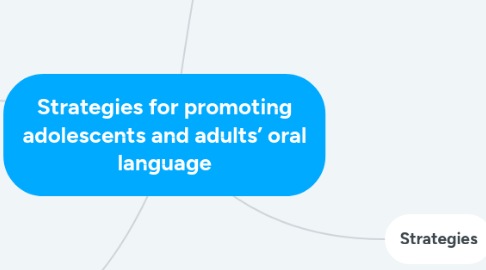
1. References Solano, L. (2021). Itinerary I: Methodology for Teaching English to Adolescents and adults. Unit 4: Techniques and Strategies for Teaching English to adolescents and adults. Universidad Técnica Particular de Loja. Cloud, N., Lakin, J., Leininger., & Maxwell, L. (2010). Teaching Adolescents English Language Learners. Essential Strategies for Middle and High School. Chapter 5: Oral Language. Caslon Publishing
2. By Angie Lizbeth Moreno Choez
3. Aspects of oral language
3.1. Phonetics and phonology: The sound system
3.2. Morphology: Word formation
3.3. Syntax: Grammar or sentence structure
3.4. Semantics: Word meaning
3.5. Pragmatics: Language use in context
4. Strategies
4.1. Writing and Visual Scaffolds
4.1.1. Acquiring Discussion Rules
4.1.1.1. - Taking turns (nonverbal actions) - Register (volume, tone and level of formality) - Staying on topic (stay focused and work through the topic or idea at hand) - Responding intelligently
4.1.2. Acquiring Discussion
4.1.2.1. - Scripts - Idea-Linking Words
4.1.3. Practicing Discussion Skills
4.1.3.1. - Yes/no questions - Images and physical movements to express or ask - Fill-in-the-blank - Open-ended questions
4.1.4. Acquiring Text-Based Discussions Skills
4.1.4.1. - Listen actively - Build on or add to what others say - Patiently take turns while allowing conversations to flow - Talk to and look at each other rather than through or at the teacher - Ask questions to clarify if confused - Monitor speaking time to allow multiple voices - Continue to refer to the text, using page, paragraph, and line numbers whenever possible.
4.1.5. Acquiring Questioning Skills
4.1.5.1. - Internalize the patterns and rhythms of basic questions
4.1.6. Using Visual Scaffolds
4.1.6.1. - Pictures - Realia - Maps - Graphs - Diagrams - Graphic organizer
4.1.7. Giving Students Feedback
4.1.7.1. According to Cloud et al., (2010) “The type and amount of language feedback each student should receive depends on the student.” (p. 113.)
4.1.7.2. Feedback on accent Pronunciation:
4.1.7.3. The feedback should only be given if a students’ pronunciation inhibits others’ comprehension of what the speaker says. (Rothenberg & Fisher, 2007)
4.1.7.4. Feedback on Vocabulary Usage and Grammar:
4.1.7.4.1. Try to limit the feedback and corrections on current lessons.
4.1.7.4.2. Straddles the line between vocabulary usage and grammar learning (nouns versus verbs, use of phrasal verbs)
4.1.7.4.3. Multiple-meaning words, reducing the number of new vocabulary words.
4.2. Vocabulary Learning
4.2.1. Shades of meaning
4.2.1.1. - Use of a scale, for students to grasp shades of meaning. - Using adverbs to describe how the action of similar verbs happens. - Distinguishing between positive and negative nuances of meaning.
4.2.2. Slang versus formal vocabulary
4.2.2.1. - Discussing private, or group-specific, language versus public English.
